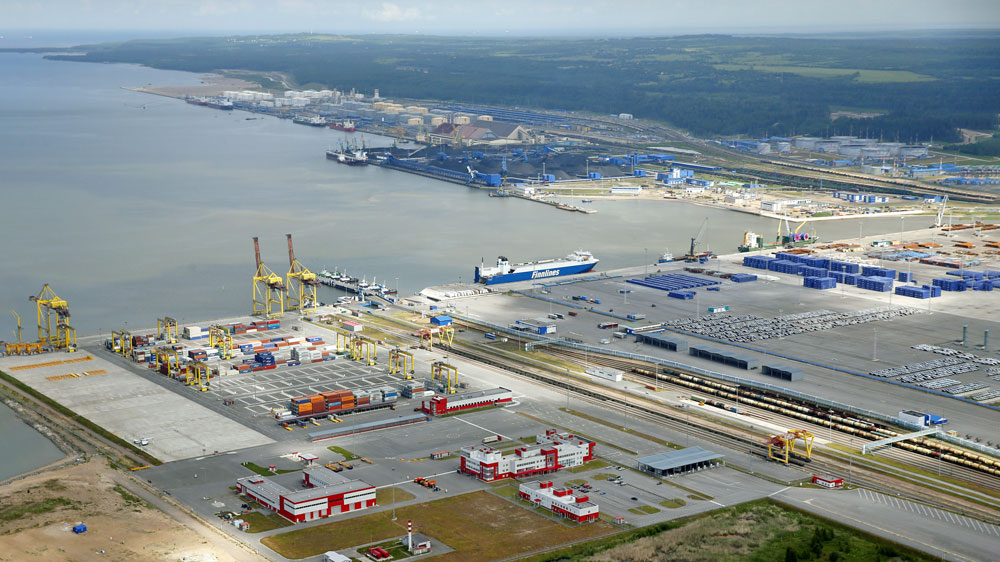Gazprom and RusKhimAlyans Setting up Complex for Processing Ethane-containing Gas
The Largest Capacity in Russia in Terms of Gas Processing & The Largest in North-Western Europe in Terms of LNG Production
Gazprom and RusKhimAlyans (the project operator of the integrated complex for natural gas processing and liquefaction; the company was established on a parity basis by Gazprom and RusGazDobycha) signed 20-year commercial contracts for supplies of feed gas and sales gas. Thus, the integrated complex will be provided with raw materials for the long term.
The documents establish the following pattern of cooperation. Ethane-containing natural gas will be supplied from Gazprom’s fields to RusKhimAlyans in the amount of 45 billion cubic meters per year. The gas remaining after the processing (extraction of ethane fraction and other valuable components) and production of liquefied natural gas will go into the Company’s gas transmission system in the amount of approximately 18 billion cubic meters per year.
In addition, a contract was signed between RusKhimAlyans and Baltic Chemical Complex (a wholly-owned subsidiary of RusGazDobycha) to supply ethane fraction for further processing at the gas chemical facility technically affiliated with the integrated complex. The supply period under the contract is 20 years.
RusKhimAlyans entered into an EPC contract with NIPIGAZ (part of the SIBUR Group) for a full cycle of operations to create gas processing and off-site facilities at the complex. The contractor will prepare the working documentation, ensure the delivery of equipment & materials and the execution of construction & installation and start-up & commissioning works, and provide integration services for the complex and its off-site facilities.
By now, NIPIGAZ completed a set of engineering surveys and developed basic technical solutions for RusKhimAlyans under the contract signed in September 2019. Currently, design documentation is being drafted for the gas processing facilities.
Later on, RusKhimAlyans will select ЕРС contractors to build natural gas liquefaction facilities, a storage facility for raw materials and marketable products, a marine shipment terminal, and other non-production facilities. An ЕРСМ contractor will be chosen to carry out integrated management of the construction process for the integrated complex.
Strategy
The creation of a large-scale complex that will process ethane-containing gas and produce liquefied natural gas (LNG) near the settlement of Ust-Luga, Leningrad Region, is a practical manifestation of the new economic model for the comprehensive monetization of hydrocarbon resources.
This enterprise is of great significance for Russia’s social and economic development. The plant will make it possible to increase Russian exports of LNG and liquefied petroleum gases (LPG). The production of ethane, which is in high demand in the domestic industry, will grow substantially.
Figures and facts
The complex will have the largest capacity in Russia in terms of gas processing and will be the largest in north-western Europe in terms of liquefied natural gas production. Every year, it will process 45 billion cubic meters of gas and produce 13 million tons of LNG, up to 3.8 million tons of ethane fraction, up to 2.4 million tons of LPG, and 0.2 million tons of pentane-hexane fraction. The gas remaining after the processing (about 19 billion cubic meters) will go into Gazprom’s gas transmission system.
Combining the production of LNG and ethane within one industrial site will have a strong beneficial effect on the economics and specific indicators of the project and will considerably mitigate the resource and price risks.
The enterprise will be processing ethane-containing gas extracted by Gazprom from the Achimov and Valanginian deposits of the Nadym-Pur-Taz region.
During its most active phase, the construction will involve over 25,000 specialists, with more than 5,000 permanent jobs to be created to man the operation of the facility.
The ethane produced at the plant is to be supplied to a high-potential gas chemical facility (a project by RusGazDobycha), which will be producing over 3 million tons of polymers per year.
Project implementation
In May 2017, Gazprom and RusGazDobycha signed a Memorandum of Intent to implement projects aimed at advancing petrochemical production on the basis of the Achimov and Valanginian deposits within the Nadym-Pur-Taz region, as well as extracting and processing gas and gas condensate from the fields within the Tambey cluster (Tambeyskoye and Tasiyskoye fields owned by Gazprom).
In March 2019, Gazprom and RusGazDobycha made a decision on the final configuration of the project for a large-scale complex for processing ethane-containing gas and LNG production near the settlement of Ust-Luga, Leningrad Region. Thus, the parties moved to the implementation stage in the project.
It is expected to put the first train of the complex into operation in the fourth quarter of 2023 and the second train in the fourth quarter of 2024.
Project for LNG supplies to Kaliningrad Region
On January 8, 2019, an offshore gas receiving terminal and a floating storage and regasification unit called Marshal Vasilevskiy were put into operation in the Kaliningrad Region.
Prior to that event, the Kaliningrad Region used to receive natural gas via the transit gas pipeline Minsk – Vilnius – Kaunas – Kaliningrad.
In order to enhance the region’s energy security taking into account its geographical setting, Gazprom carried out an alternative gas supply project focused on liquefied natural gas (LNG) deliveries by sea.
To that end, a gas receiving terminal was built in the offshore and coastal areas of the Baltic Sea. A key component of the terminal is a fixed marine berth with a breakwater. This facility is unique as far as domestic engineering practices are concerned. It is located 5 kilometres from the shore, where the sea is about 19 meters deep, which allows the floating storage and regasification unit (FSRU) to be moored.
The berth is a 125.5-meter monolithic slab of high-strength concrete resting on 177 piles. Special equipment for receiving gas is installed on top of the slab along with mooring devices. The berth is protected from waves with a robust 728-meter C-shaped breakwater. The breakwater has a complex structure, with 29 metal cylinders (20 meters in diameter, 21 meters in height, and weighing over 200 tons each) placed along the full length of the stone foundation (so-called stone base) that rests on the seabed. The cylinders are filled with rubble and their outer surface has an anticorrosion polymer coating. From the seaward, the cylinders are bolstered by a mound of rocks (weighing up to 6 tons each) and more than 20,000 special reinforced concrete blocks (tetrapods weighing from 7.8 to 25 tons). This berth was designed so as to help the vessel operate safely and to withstand severe storms, which are not uncommon in the Baltic Sea.
Marshal Vasilevskiy is the only FSRU in Russia. The vessel transports LNG (174,000 cubic meters of reservoir capacity) and performs regasification operations, converting LNG to gaseous form. The FSRU has three regasification lines (including one backup line). The regasification process starts at the FSRU as soon as the vessel is moored at the berth. Liquefied gas is converted to gaseous form and fed into the existing gas transmission system via a newly-built 13-kilometer connecting gas pipeline. Afterwards, gas is delivered to consumers or injected into the Kaliningradskoye UGS facility.
Thanks to the terminal and the FSRU, up to 3.7 billion cubic meters of gas can be delivered by sea on an annual basis. If necessary, the new facilities will meet the current and future needs of the Kaliningrad Region.
Vladivostok LNG project
The Vladivostok LNG project envisages the construction of the LNG plant near the city of Vladivostok. Potential sales markets are concentrated in Asia-Pacific.
Sakhalin II
Russia’s first liquefied natural gas plant
Eastern Siberia and the Russian Far East are top priority regions for Gazprom in the long term.
The state policy on the gas industry development in eastern Russia is outlined in the Development Program for an integrated gas production, transportation and supply system in Eastern Siberia and the Far East, taking into account potential gas exports to China and other Asia-Pacific countries (Eastern Gas Program). Gazprom serves as the Program coordinator.
The project includes the ongoing development of the Piltun-Astokhskoye and Lunskoye oil and gas fields in the Sea of Okhotsk under a production sharing agreement.
The Trans-Sakhalin pipeline system conveys extracted oil and gas via an onshore processing facility to the Prigorodnoye production complex that comprises an LNG plant and an oil export terminal.
Figures and facts
Sakhalin Energy Investment Company Ltd. (Sakhalin Energy) is the Sakhalin II project operator.
In 2018, Sakhalin Energy extracted 3.98 million tons (28.29 million barrels) of oil and 1.58 million tons (13.93 million barrels) of condensate and produced 11.41 million tons of LNG.
Project implementation
April 1994: Sakhalin Energy is set up.
June 22, 1994: Sakhalin Energy, the Government of the Russian Federation, and the Administration of the Sakhalin Region sign the Production Sharing Agreement to develop the Piltun-Astokhskoye and Lunskoye oil and gas fields.
1996: The project’s Phase 1 is launched.
1999: The Piltun-Astokhskoye field begins producing oil.
2003: Phase 2 starts, providing for the comprehensive development of the Piltun-Astokhskoye and Lunskoye fields.
2007: Gazprom joins the Sakhalin II project.
2009: The first Russian LNG plant is commissioned in Sakhalin. The design capacity of its two production trains is 9.6 million tons of LNG per year.
2015: In June, Gazprom and Shell sign the Memorandum to construct the third production train of the LNG plant within Sakhalin II. The document sets target dates for the design stage and the project implementation in general and outlines further steps and main principles of cooperation between the parties in preparing a final investment decision.
In December, Sakhalin Energy starts to develop design documentation.
Molikpaq (Piltun-Astokhskaya-A) platform
The Molikpaq (Piltun-Astokhskaya-A) platform is the first offshore oil production platform in Russia. Between 1999 and 2008, the platform was the core facility of the Vityaz production complex that also included the Okha tanker (double-hull floating storage and offloading unit), a single-anchor leg mooring buoy, and a subsea pipeline.
The production complex was used to perform oil drilling, production and offloading, as well as related support and exploration activities. Oil was produced during ice-free periods for about six months per year.
Year-round production at the platform started in December 2008. From the Molikpaq platform, oil travels through the Trans-Sakhalin pipeline system to the oil export terminal of the Prigorodnoye production complex.
Piltun-Astokhskaya-B platform
The Piltun-Astokhskaya-B platform is the largest platform within the Sakhalin II project. Since the end of 2008, the platform has been extracting oil and associated gas from the Piltunskaya feature of the Piltun-Astokhskoye oil field. The Trans-Sakhalin pipeline system delivers hydrocarbons to the LNG plant and oil export terminal of the Prigorodnoye complex. The platform is designed to operate all year round in severe weather conditions and under heavy wave, ice and seismic loads.
Lunskaya-A (LUN-A) platform
The Lunskaya-A (LUN-A) platform is the first offshore gas production platform in Russia. The platform produces the bulk of gas under Sakhalin II. Such operations as oil, condensate and gas separation, including gas treatment for transportation to the LNG plant, are performed at the onshore processing facility. The platform is designed to operate all year round in severe weather conditions and under heavy wave, ice and seismic loads.
LNG plant
The LNG plant comprises two production trains and general service facilities. The production trains are used for gas treatment and liquefaction. The double mixed refrigerant technology applied in LNG production was developed by Royal Dutch Shell.
That state-of-the-art technology was developed specifically for the Sakhalin LNG plant to ensure its maximum efficiency during cold Sakhalin winters. The design capacity of the plant is 9.6 million tons of LNG per year.







